FAQ - Advanced Bathroom Queries
What Does Gpf Mean on a Toilet Tank

Ever been curious about the significance of GPF labeled on your toilet tank? We’re here to deliver the explanations you’re looking for.
In this article, we will explore the importance of understanding GPF, its definition, how it is measured, and the historical background behind it.
We will also discuss the environmental impact of GPF and provide tips on how to calculate and reduce GPF usage.
So, let’s dive in and become masters of toilet knowledge!
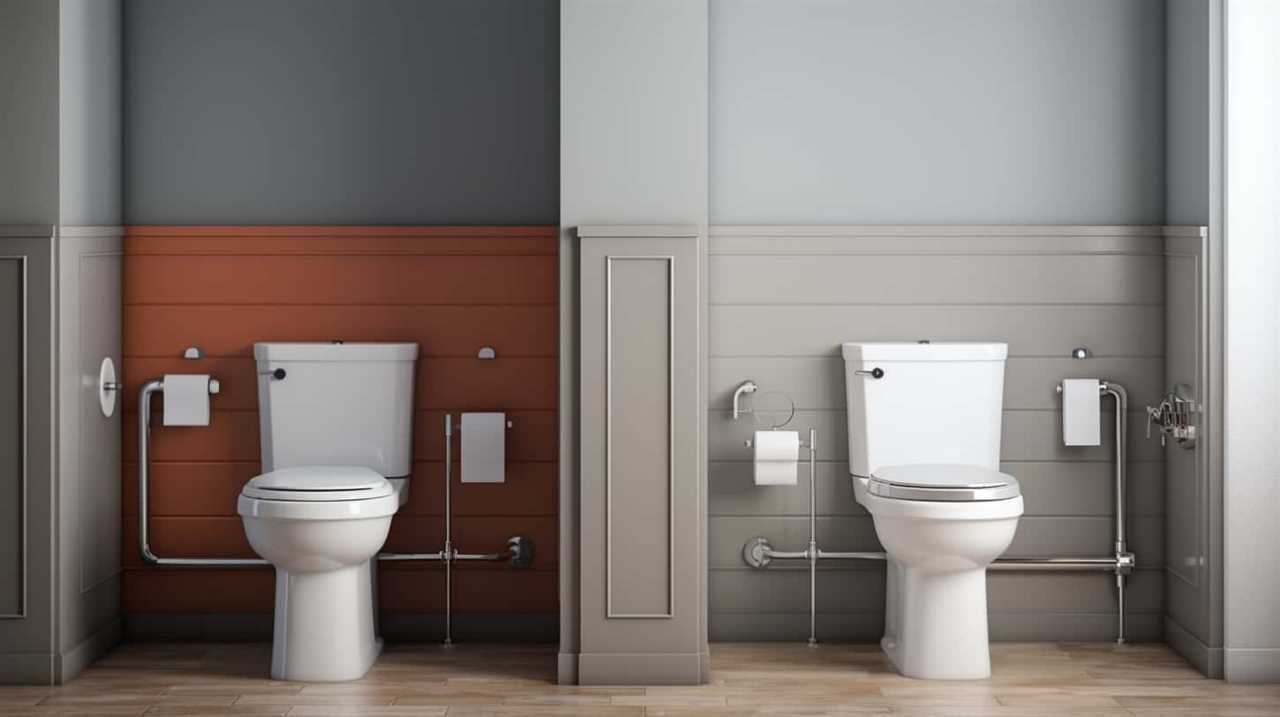
Key Takeaways
- GPF stands for gallons per flush and is a measurement used to determine the amount of water a toilet uses to flush.
- Lowering GPF helps in maximizing water efficiency and can save money on water bills.
- Traditional toilets have higher GPF values, while newer models have lower GPF values, reducing water consumption without compromising performance.
- GPF standards and regulations aim to reduce water wastage, promote sustainability, and address water scarcity.
Importance of Understanding GPF
Understanding the importance of knowing the GPF (gallons per flush) of a toilet is crucial for us as homeowners. Water saving initiatives have become increasingly important in recent years, and knowing the GPF of our toilets allows us to contribute to these efforts.
By choosing a toilet with a lower GPF, we can significantly reduce our water consumption and contribute to the conservation of this valuable resource.
Additionally, understanding the impact of GPF on our plumbing systems is essential. Higher GPF toilets often put more strain on our pipes and sewage systems, leading to potential clogs and increased maintenance costs.
Definition of GPF
GPF, or gallons per flush, is a measurement used to determine the amount of water a toilet uses to flush. Understanding GPF is important because it directly affects water efficiency and can impact water bills.
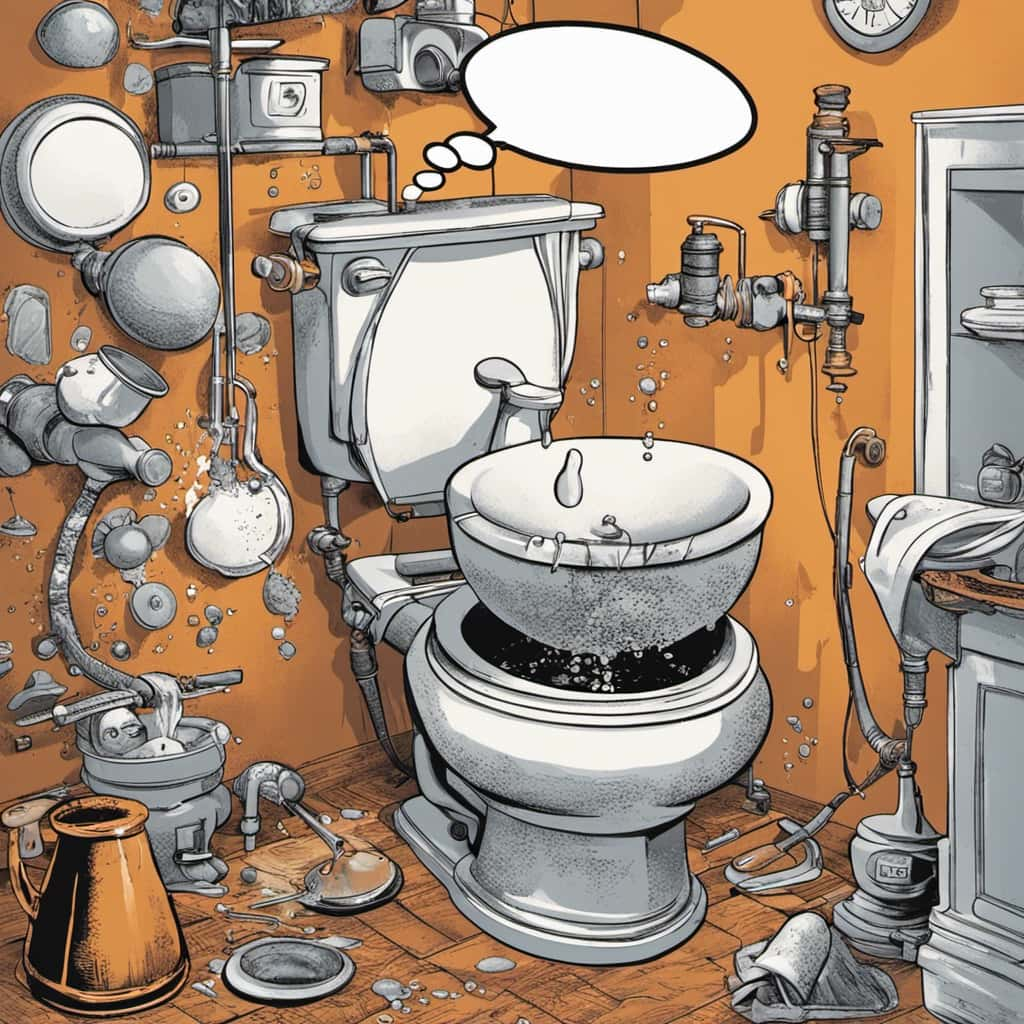
GPF and Water Efficiency
To maximize water efficiency, we can reduce the gallons per flush (GPF) of a toilet by using a lower volume of water for each flush. Water-saving measures, such as reducing the GPF, play a crucial role in conserving water and promoting sustainability.
GPF refers to the amount of water used per flush in a toilet. Traditional toilets typically have a GPF of around 3.5 or more, while newer models are designed to have lower GPF values, such as 1.6 or even 1.28. By using less water per flush, these toilets help reduce water consumption without compromising performance.
Plumbing systems are an integral part of ensuring water efficiency, and by using toilets with lower GPF, we can contribute to a more sustainable future.
Impact on Water Bills
Continuing the discussion from the previous subtopic, using a lower GPF in toilets can have a significant impact on our water bills. Implementing water saving strategies not only helps conserve water but also reduces the financial burden on our household budget.

Here are some key ways in which a lower GPF can save us money:
- Reducing water consumption by opting for toilets with lower GPF.
- Lowering the amount of water wasted with each flush.
- Decreasing water usage without compromising on flushing efficiency.
- Minimizing the strain on our water resources while maintaining a cost-effective approach.
Choosing the Right GPF
Now let’s explore how to select the right GPF for our specific needs, considering the definition of GPF and its impact on water consumption and cost savings.
GPF stands for Gallons Per Flush and refers to the amount of water flushed down the toilet with each use. Choosing the right GPF is crucial as it directly affects water consumption and cost savings.
When comparing GPF options, it’s important to consider the toilet design as well. Older toilets typically have higher GPF ratings, ranging from 3.5 to 7 GPF, whereas newer, more efficient toilets have lower GPF ratings, typically ranging from 1.28 to 1.6 GPF.
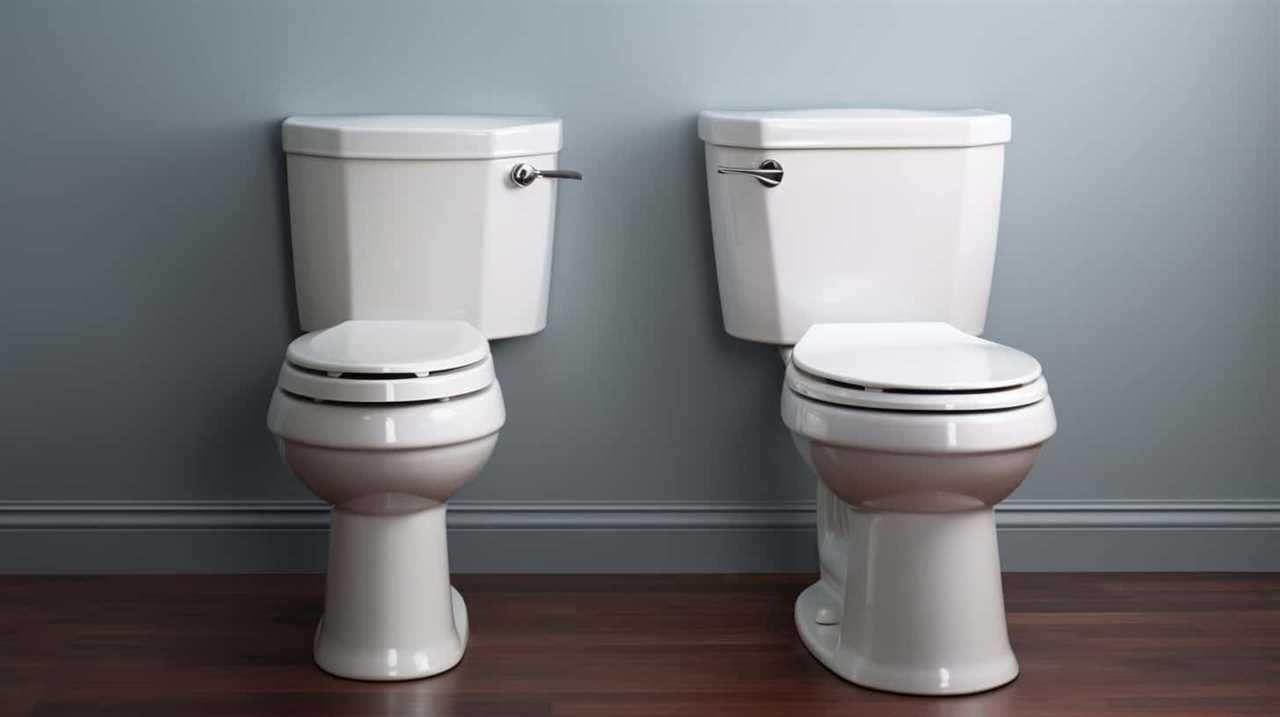
How GPF Is Measured
When it comes to determining the amount of water used by a toilet, the measurement of gallons per flush (GPF) is determined through the use of a water meter. To ensure measuring accuracy, manufacturers use a GPF conversion formula that takes into account the volume of water released during a flush.
Here is a breakdown of how GPF is measured:
- Water meter: A device installed in the toilet’s water supply line that measures the amount of water flowing into the tank.
- Flush test: A controlled experiment where the toilet is flushed multiple times, and the water meter records the volume of water used.
- Calculation: Using the GPF conversion formula, the volume of water measured by the water meter is converted into gallons per flush.
- Certification: Toilet manufacturers submit their models for testing to independent organizations, such as the Environmental Protection Agency, to ensure compliance with GPF regulations.
Understanding how GPF is measured allows consumers to make informed decisions when choosing a toilet that meets their water conservation needs.
Historical Background of GPF
To understand the historical background of GPF, we can trace its origins back to the early development of modern plumbing systems. GPF, or gallons per flush, refers to the amount of water used by a toilet when it’s flushed.
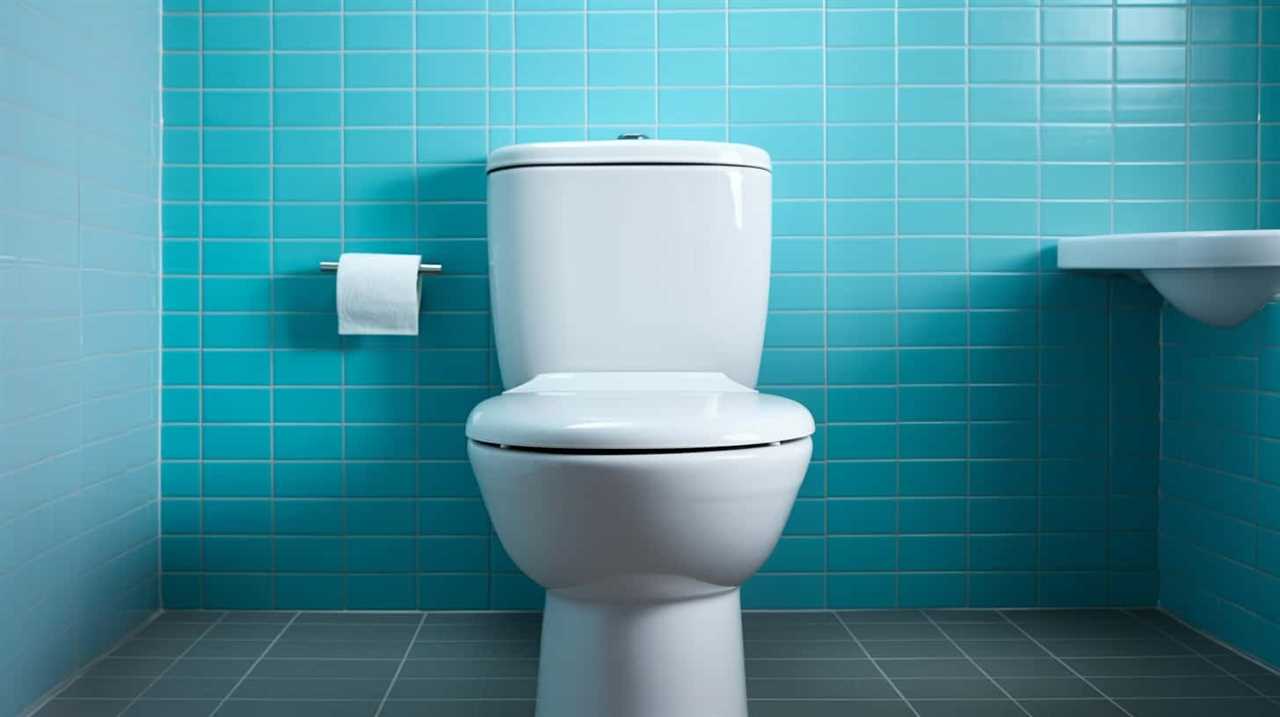
Over time, there’s been an evolution in GPF, driven by the need for water conservation and efficiency. In the past, toilets used a much higher GPF, typically around 3.5 to 7 gallons per flush.
However, with advancements in technology and a growing focus on sustainability, modern toilets now have a much lower GPF, typically ranging from 1.28 to 1.6 gallons per flush. This reduction in GPF has significantly contributed to water conservation efforts and has become the standard in many countries.
Understanding the historical evolution of GPF is crucial in appreciating the current standards and regulations in place to ensure water efficiency and sustainability.
GPF Standards and Regulations
GPF standards and regulations play a crucial role in water conservation efforts. By limiting the amount of water used per flush, these regulations aim to reduce water wastage and promote sustainability.
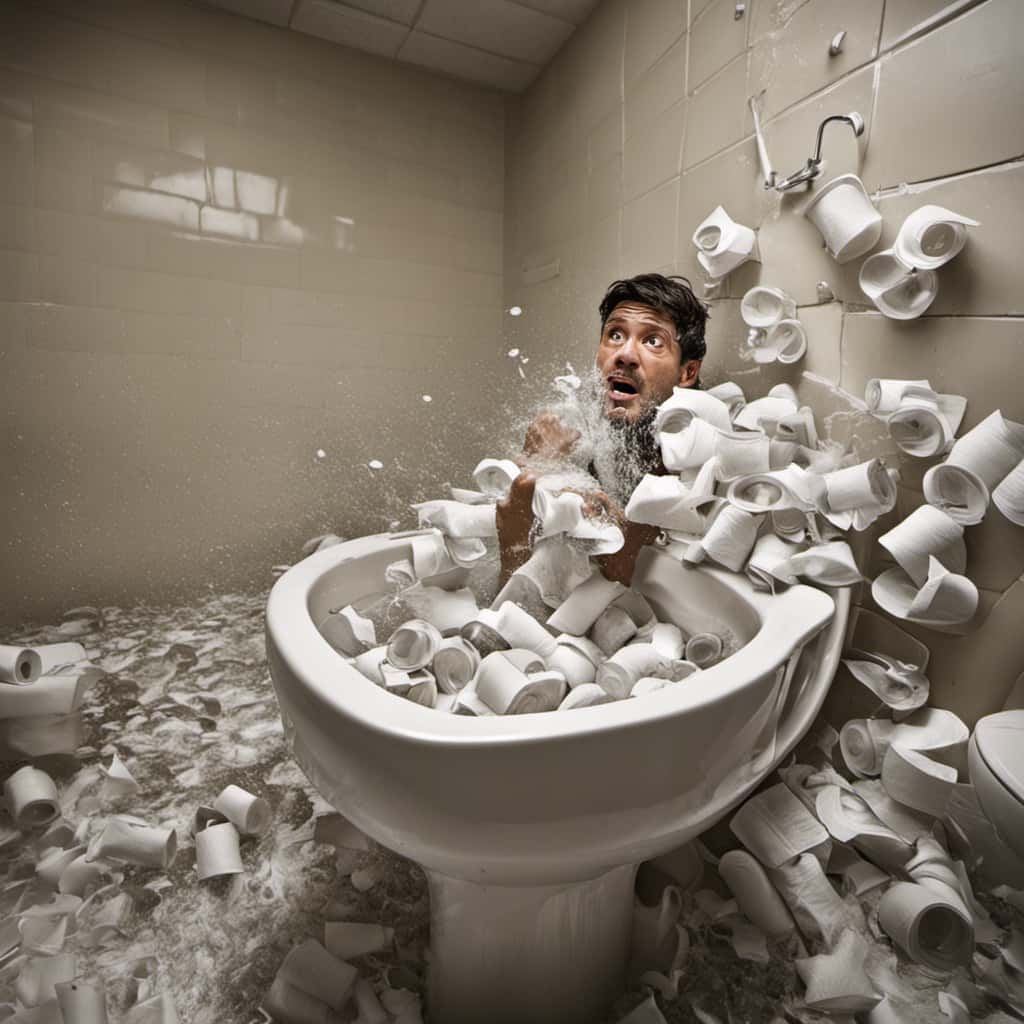
The impact of GPF regulations can be seen in the significant decrease in water consumption over the years, making toilets more efficient and environmentally friendly.
GPF and Water Conservation
In our efforts to promote water conservation, we adhere to the GPF standards and regulations established for toilet tanks. These regulations play a crucial role in reducing water consumption and addressing water scarcity.
Here are some key points to understand about GPF and water conservation:
- GPF and toilet design: The GPF rating on a toilet tank indicates the number of gallons of water used per flush. Modern toilets are designed to be more efficient, using less water without compromising on performance.
- GPF and water scarcity: With increasing concerns about water scarcity, it’s essential to minimize water wastage. By adhering to GPF standards, we can significantly reduce water usage in households and conserve this precious resource.
- GPF regulations and environmental impact: The implementation of GPF regulations has led to significant water savings on a large scale. These regulations have helped reduce the strain on water resources and contribute to a more sustainable future.
Impact of GPF Regulations
By consistently adhering to GPF (gallons per flush) standards and regulations, we can actively contribute to the positive impact of water conservation efforts. These regulations aim to reduce the amount of water used in each flush, resulting in significant water savings over time. However, it is important to understand that there can be an impact on toilet performance with lower GPF requirements. To illustrate this, let’s take a look at the table below:
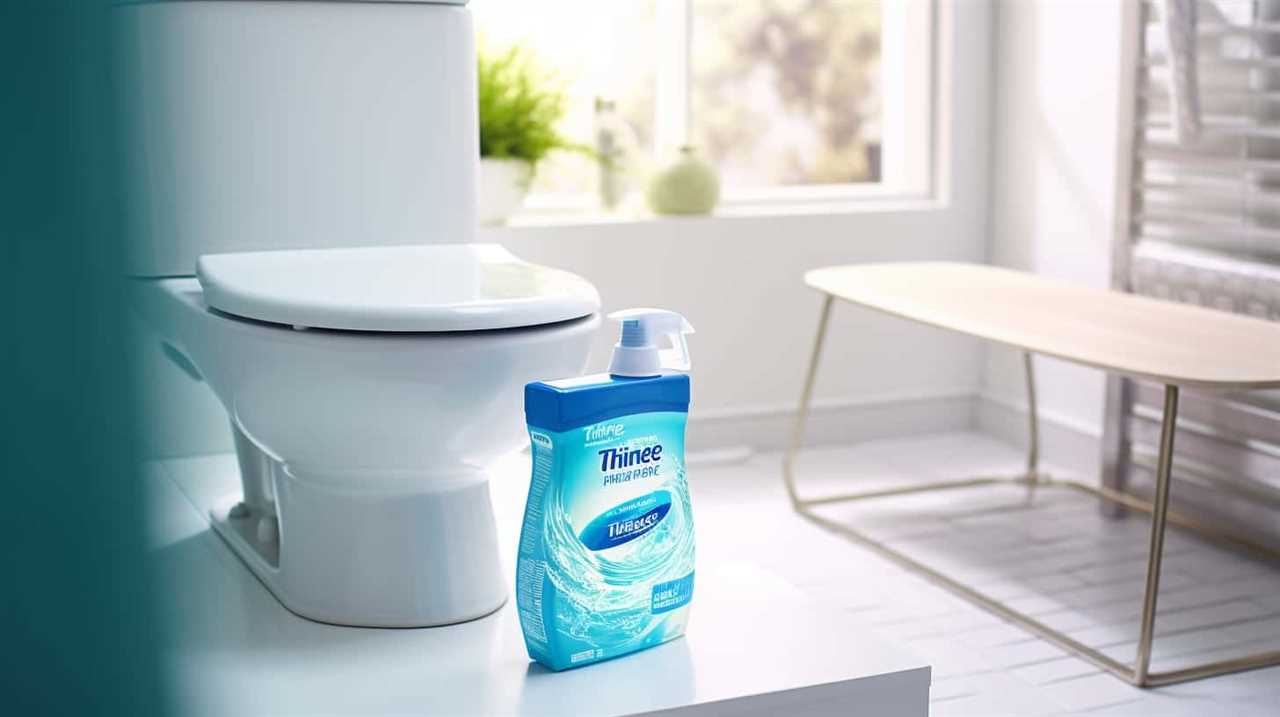
| GPF Requirement | Water Savings (per year) | Toilet Performance |
|---|---|---|
| 1.6 | 7,300 gallons | High efficiency |
| 1.28 | 9,125 gallons | Good efficiency |
| 1.0 | 11,500 gallons | Moderate efficiency |
As the GPF requirement decreases, there is a corresponding increase in water savings. However, it is essential to choose a toilet that balances water conservation with efficient performance. Manufacturers have developed innovative technologies and designs to ensure that toilets with lower GPF requirements still provide effective flushing power. By selecting a toilet that meets both GPF regulations and performance needs, we can make a significant impact on water conservation while maintaining a high level of functionality.
Different GPF Options Available
We can explore the various options available for toilet tanks in terms of gallons per flush (GPF).
When it comes to toilet efficiency, it’s important to consider the GPF options that are available. Here are some options to consider:
- 1.6 GPF: This is the standard option that has been in use for many years. It provides a decent flush while still conserving water.
- 1.28 GPF: This option is more water-efficient than the standard 1.6 GPF. It still provides a powerful flush while using less water.
- 0.8 GPF: This is an ultra-low GPF option that’s designed for maximum water conservation. It’s ideal for areas with strict water regulations.
- Dual-flush toilets: These toilets offer the option of using different GPF levels for liquid waste and solid waste, further optimizing water usage.
Now that we understand the different GPF options available, let’s explore the pros and cons of low GPF toilets.
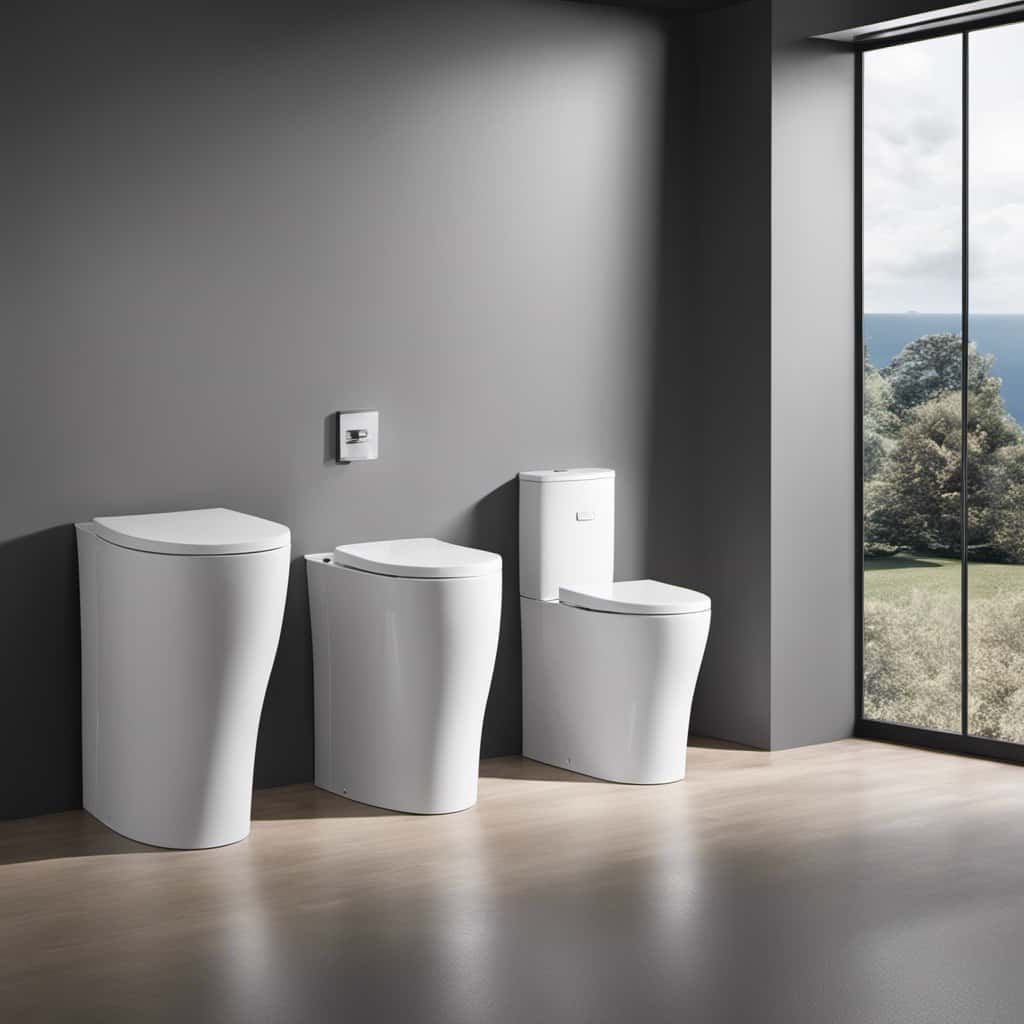
Pros and Cons of Low GPF Toilets
Low GPF toilets offer significant water conservation benefits, helping to reduce our environmental impact by using less water per flush.
However, it’s important to consider the flushing power of these toilets, as they may not be as effective in removing waste compared to higher GPF options.
Additionally, low GPF toilets can provide long-term cost-saving potential by reducing water bills, but the upfront cost of purchasing and installing these toilets should also be taken into account.
Water Conservation Benefits
With the aim of reducing water consumption, the benefits and drawbacks of toilets with a low GPF are worth considering. Low flow toilets, also known as water-saving toilets, offer several advantages when it comes to water conservation. Here are some key benefits to keep in mind:

- Efficient flushing: Low flow toilets use less water per flush, typically around 1.28 gallons per flush (GPF) compared to the standard 1.6 GPF. This results in significant water savings over time.
- Cost savings: By reducing water usage, low flow toilets can lead to lower water bills, providing financial benefits for homeowners and businesses alike.
- Environmental impact: With less water being used for flushing, low flow toilets help conserve water resources and reduce strain on water treatment facilities.
- Compliance with regulations: Many regions have implemented water conservation regulations that require the use of low flow toilets, making them a necessary choice for compliance.
While low flow toilets offer numerous benefits, it’s important to consider potential drawbacks such as reduced flushing power and the need for occasional double flushing. However, with advancements in technology, these drawbacks are becoming less of an issue, making low flow toilets an effective solution for water conservation.
Flushing Power Comparison
One important aspect to consider when comparing flushing power is the impact of different GPF levels on toilet performance. Flushing power refers to the ability of a toilet to effectively remove waste with a single flush.
Low GPF toilets, typically ranging from 1.28 to 1.6 gallons per flush, are designed to conserve water while still providing sufficient flushing power. These toilets use innovative technologies such as pressure-assisted flushing or larger trapways to maximize the efficiency of each flush.
However, it’s important to note that some low GPF toilets may not perform as well as higher GPF toilets when it comes to flushing bulk waste.
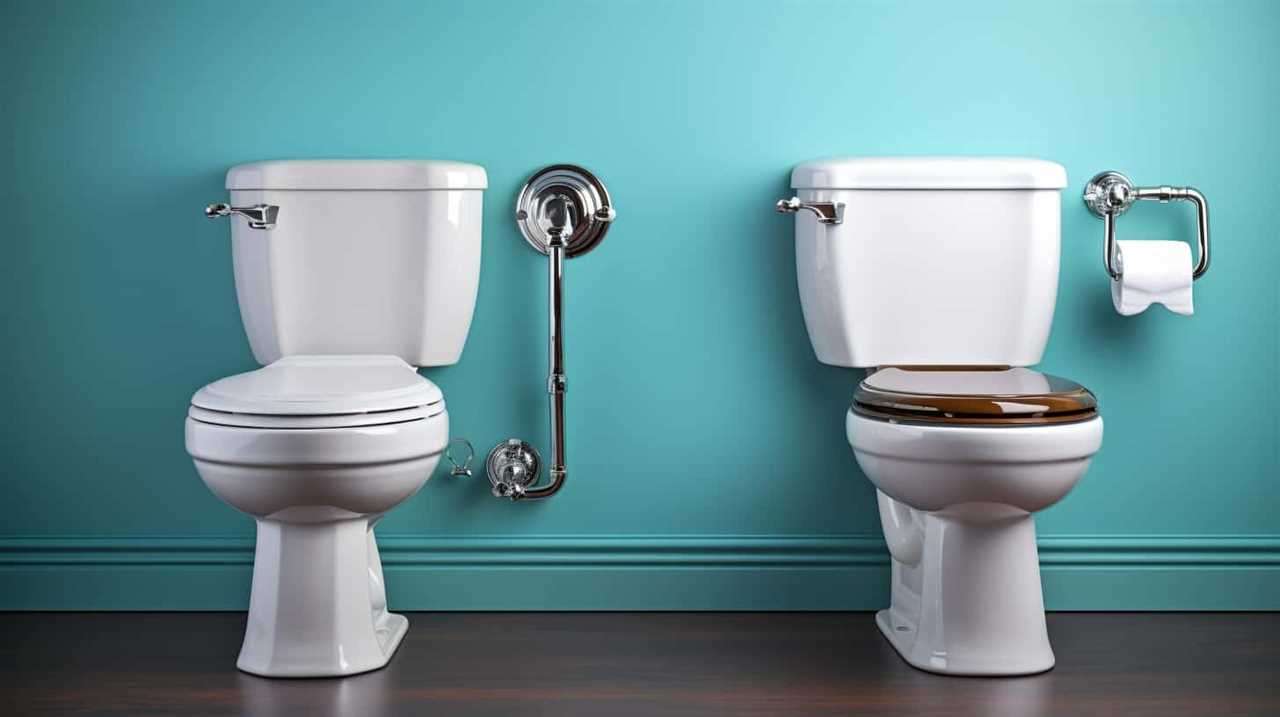
This trade-off between water usage and flushing power should be considered when choosing a toilet, as it ultimately depends on personal preference and specific needs.
Cost-Saving Potential Analysis
Our analysis of the cost-saving potential of low GPF toilets reveals the benefits and drawbacks of these water-conserving fixtures. When considering the GPF cost analysis and GPF savings potential, here is what you need to know:
- Reduced water consumption: Low GPF toilets use significantly less water per flush, which can lead to substantial water savings over time.
- Lower water bills: With less water being used, homeowners can expect to see a decrease in their monthly water bills.
- Environmental impact: By conserving water, low GPF toilets contribute to a more sustainable and eco-friendly lifestyle.
- Potential drawbacks: While low GPF toilets offer cost-saving benefits, they may have lower flushing power compared to higher GPF toilets, which could result in the need for multiple flushes.
Considering these factors, it’s important to weigh the pros and cons of low GPF toilets against the benefits and drawbacks of high GPF toilets.
Pros and Cons of High GPF Toilets
Although high GPF toilets have some advantages, there are also drawbacks to consider.
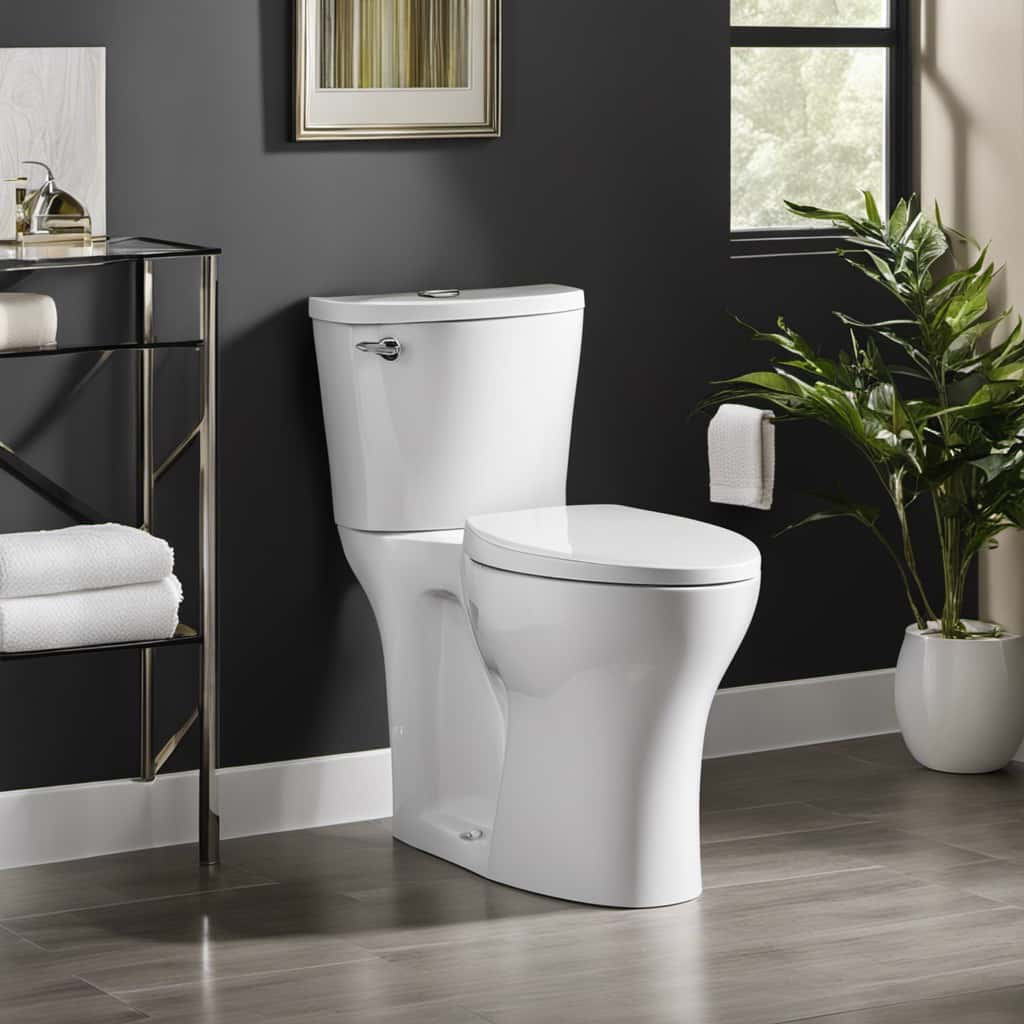
One of the main benefits of high GPF toilets is that they provide a powerful flush, which can be helpful in removing waste effectively. Additionally, high GPF toilets may be more affordable compared to low GPF toilets, making them a cost-effective option for some consumers.
However, there are also downsides to using high GPF toilets. Firstly, they consume more water per flush, which can lead to higher water bills and have a negative environmental impact. Furthermore, high GPF toilets may contribute to water scarcity in areas where water resources are limited.
Therefore, when choosing a GPF for your toilet, it’s important to consider factors such as water saving options and the environmental impact of your choice.
Factors to Consider When Choosing GPF
When selecting the GPF for your toilet, it’s essential to consider various factors. Here are some factors to consider when choosing the GPF for your toilet:
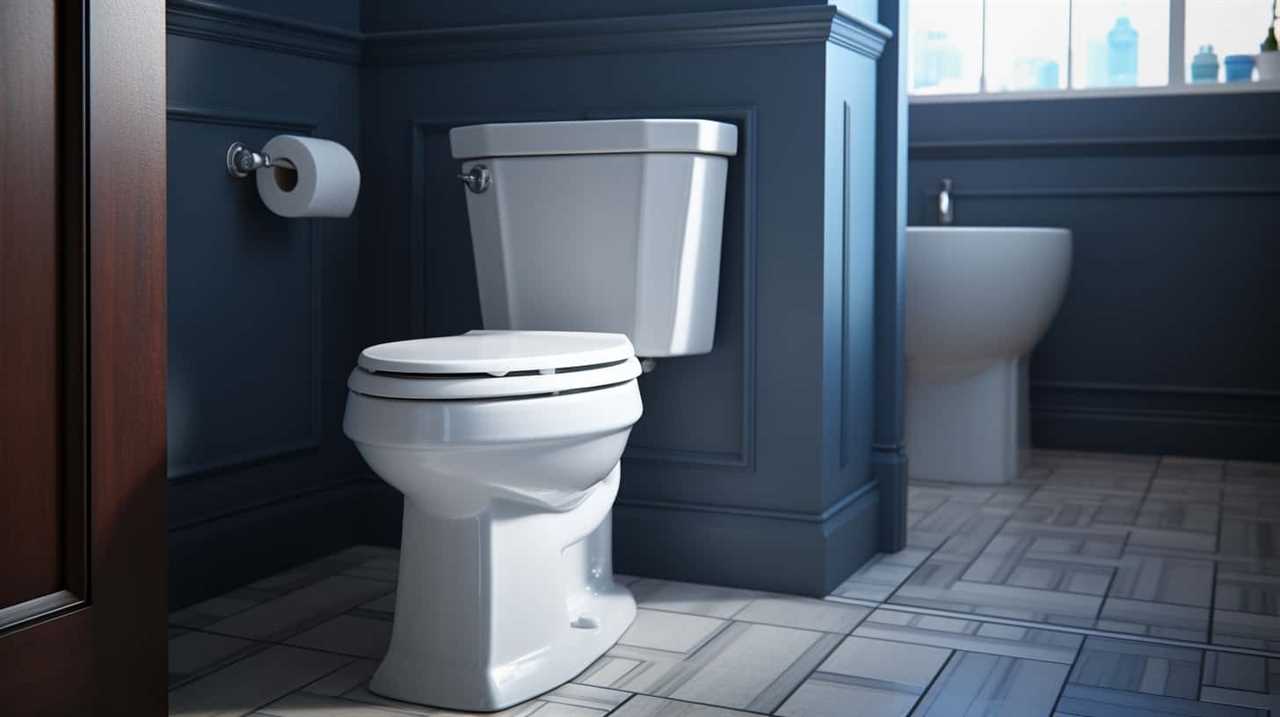
- Water efficiency: Look for toilets that have a low GPF rating, such as 1.28 or 1.6 GPF. These toilets are designed to conserve water and reduce water bills.
- Flush performance: Consider toilets that have a powerful flush despite their low GPF rating. Look for toilets with features like larger trapways and optimized bowl designs for efficient waste removal.
- Budget: Determine your budget and find a toilet that meets your water-saving needs without breaking the bank. Remember that water-saving options can vary in price, so choose one that fits your budget.
- Durability: Look for toilets with reliable construction and quality materials to ensure long-lasting performance and avoid costly repairs in the future.
How GPF Affects Water Consumption
Now let’s delve into how GPF directly impacts the amount of water consumed by a toilet.
GPF, or gallons per flush, is a crucial factor in determining water usage. By choosing a toilet with a lower GPF, you can significantly reduce your household’s water consumption. This not only helps you save money on your water bill but also contributes to water conservation efforts.
A toilet with a lower GPF uses less water for each flush, resulting in reduced household water usage patterns. Additionally, lower GPF toilets contribute to plumbing system maintenance by placing less strain on the pipes and reducing the risk of clogs.
Understanding the relationship between GPF and water consumption is essential for making informed choices about toilet fixtures.

Now, let’s explore the environmental impact of GPF.
Environmental Impact of GPF
When considering the environmental impact of GPF, there are three key points to discuss.
Firstly, water conservation strategies are crucial in reducing the amount of water wasted during each flush.
Secondly, the impact on sewer systems should be taken into account, as high GPF toilets can contribute to overloaded systems and increased maintenance costs.

Lastly, advancements in toilet flushing technology, such as dual-flush systems, offer a more sustainable option by allowing users to choose between a lower or higher flush depending on their needs.
Water Conservation Strategies
Our household’s water conservation strategies include reducing the environmental impact of GPF. To achieve this, we’ve implemented the following water-saving techniques and toilet design choices:
- Installing low-flow toilets: These toilets are designed to use less water per flush compared to traditional models.
- Dual-flush toilets: These toilets have two buttons, allowing us to choose between a lower GPF for liquid waste and a higher GPF for solid waste.
- Water displacement devices: Placing a filled water bottle or a brick in the toilet tank helps reduce the amount of water used during each flush.
- Regular maintenance: Ensuring that our toilets are in good working condition, with no leaks or running water, helps conserve water.
By employing these strategies, we’re actively reducing our water consumption and minimizing the environmental impact of GPF.
However, it’s important to consider the impact these water-saving measures may have on sewer systems.

Impact on Sewer Systems
To understand the impact of GPF on sewer systems, we must consider its environmental implications.
GPF, or gallons per flush, directly affects sewer system capacity and water pollution. When toilets use a higher GPF, more water is flushed into the sewer system. This increased volume of water can exceed the capacity of the system, leading to backups and overflows.
Additionally, the excess water can dilute the sewage, reducing its effectiveness in wastewater treatment plants. This can result in higher levels of pollutants, such as nitrogen and phosphorus, entering our waterways and contributing to water pollution.
Toilet Flushing Technology
Toilet flushing technology has evolved to include water-saving innovations that aim to reduce water consumption. There are several ways in which toilet flushing technology can have an environmental impact.
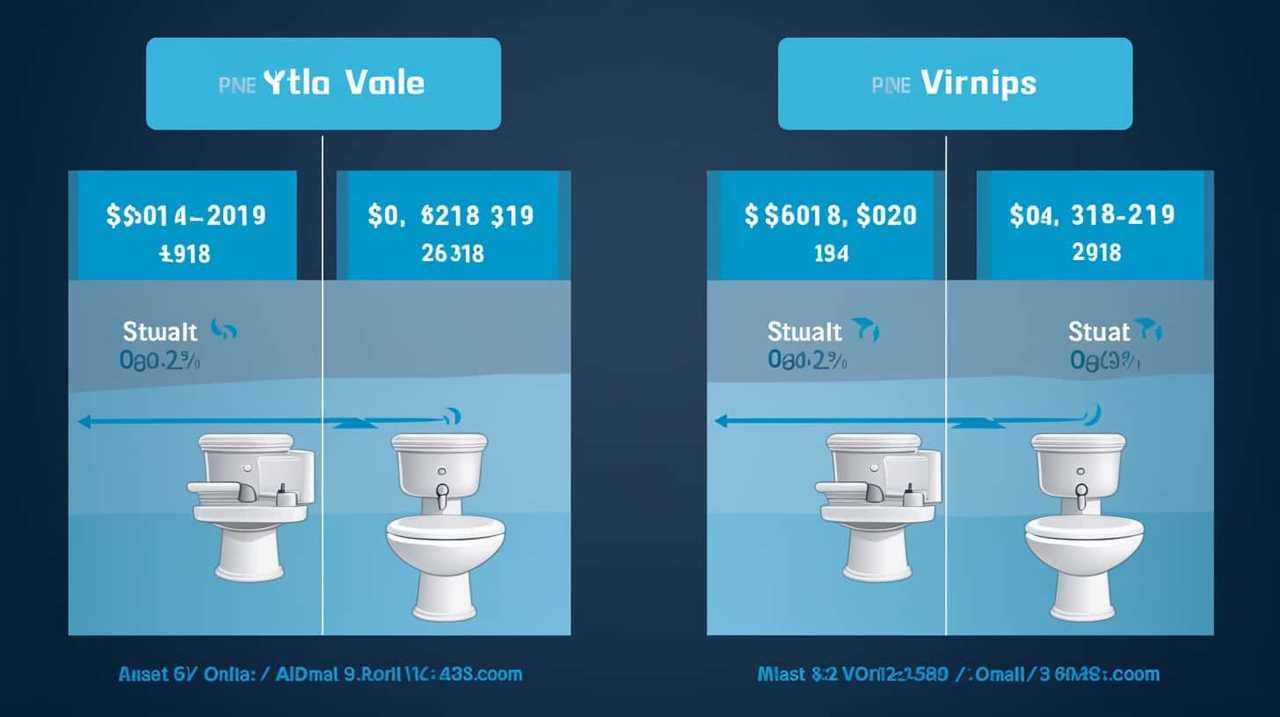
- Dual-flush toilets are designed with two flushing options, allowing users to choose between a full flush for solid waste and a partial flush for liquid waste. This effectively reduces the amount of water used.
- Pressure-assisted toilets use compressed air or water to create a powerful flush, requiring less water compared to traditional gravity-fed toilets.
- Low-flow toilets are designed with smaller tanks and redesigned bowls to optimize water usage. They typically use 1.6 gallons per flush (GPF) or less.
- High-efficiency toilets take water-saving a step further by using advanced flushing mechanisms and designs. These toilets achieve even lower GPF, often around 1.28 or even 0.8 GPF.
Implementing these water-saving technologies can minimize water waste and contribute to a more sustainable future.
Now, let’s delve into how to calculate GPF usage.
How to Calculate GPF Usage
To calculate GPF usage, we can measure the volume of water in the toilet tank before and after flushing. This method allows us to determine how much water is used per flush, providing valuable information for calculating water usage and measuring water efficiency.
To begin, we need a measuring container that can hold the entire volume of water in the tank. Before flushing, carefully place the container in the tank and note the water level. After flushing, collect the water in the container and measure its volume.
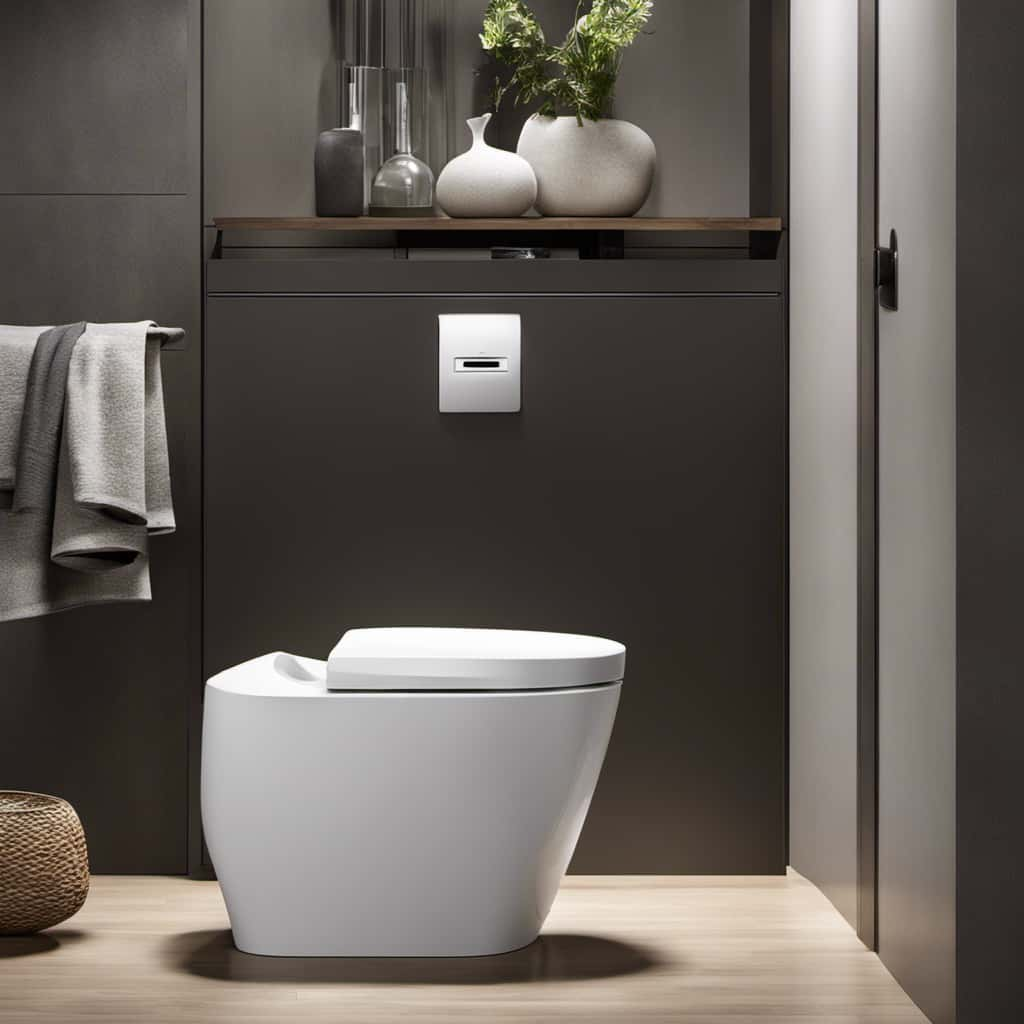
The difference between the initial and final volumes represents the amount of water used per flush, which can be converted to gallons per flush (GPF) by dividing by 128.
By accurately calculating GPF usage, we can make informed decisions about water conservation and explore ways to reduce water consumption in our toilets.
Now, let’s move on to the next section where we’ll discuss some tips for reducing GPF.
Tips for Reducing GPF
Let’s explore some ways we can cut down on GPF usage in our toilets. Here are some tips for reducing water usage and making our toilets more eco-friendly:

- Install a dual-flush toilet: These toilets have two options for flushing, allowing you to choose between a full flush for solid waste and a half flush for liquid waste. This can significantly reduce the amount of water used per flush.
- Adjust the fill valve: By adjusting the fill valve, you can ensure that the tank fills up with the right amount of water, preventing unnecessary water waste.
- Consider using a toilet tank displacement device: Placing a device such as a water-filled plastic bottle or a brick in the toilet tank can reduce the amount of water used per flush.
- Fix leaks promptly: Leaks in toilets can waste a significant amount of water. Regularly check for leaks and repair them promptly to minimize water usage.
Implementing these tips can help us reduce water usage and choose more eco-friendly toilets.
Conclusion: Making Informed Toilet Choices
When considering our options for more eco-friendly toilets, it’s important for us to make informed choices. By conducting a toilet efficiency analysis, we can evaluate the water-saving technologies available and select a toilet that meets our needs while minimizing water consumption.
Several factors should be considered during this analysis, such as the toilet’s flush volume, which is measured in gallons per flush (GPF). Opting for a toilet with a lower GPF can significantly reduce water usage. Additionally, features like dual-flush mechanisms and pressure-assisted flushing systems can further enhance water efficiency.
Understanding these technologies and their impact on water conservation allows us to choose a toilet that not only meets our personal preferences but also contributes to a more sustainable future.
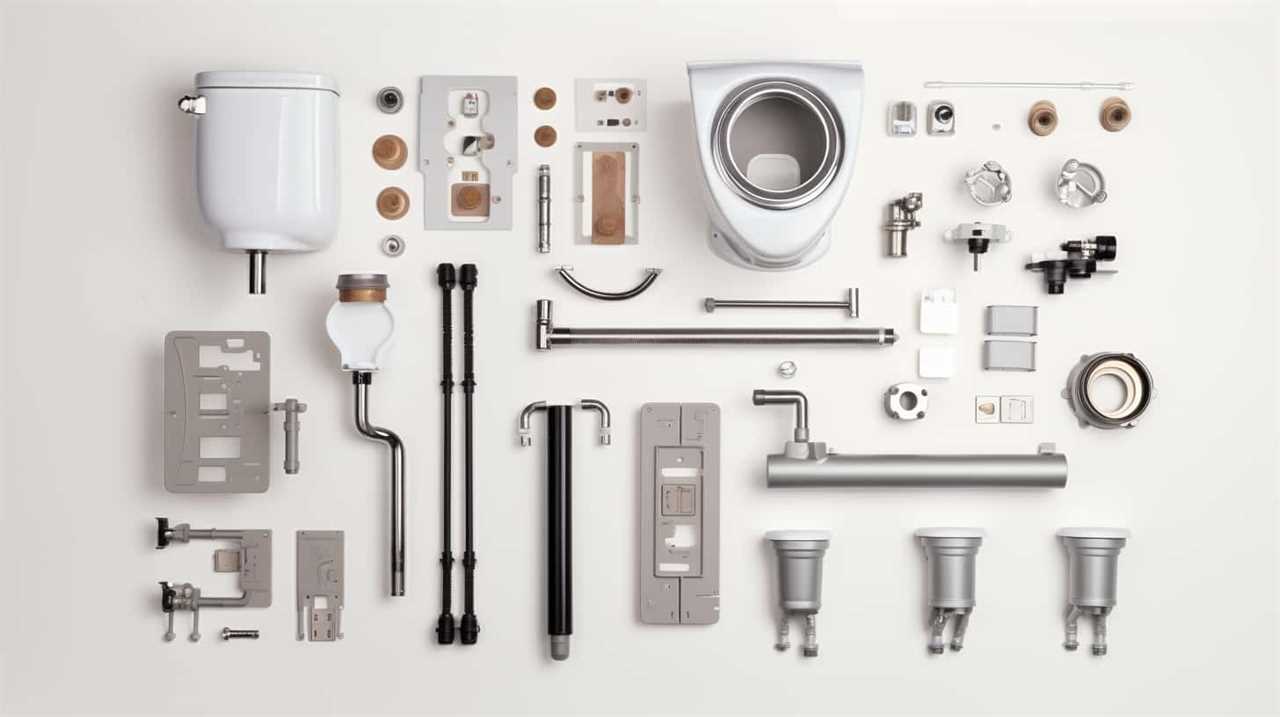
Frequently Asked Questions
Can a Toilet With a High GPF Be Converted to a Low GPF Toilet?
Yes, a toilet with a high GPF can be converted to a low GPF toilet. The conversion process involves replacing the flush mechanism. The benefits of low GPF toilets include water conservation and reduced water bills.
Are There Any Health Risks Associated With Using a Low GPF Toilet?
Using a low GPF toilet has health benefits and reduces the environmental impact. It helps conserve water and lowers the risk of waterborne diseases. Converting to a low GPF toilet is a wise choice.
How Can I Determine the GPF of My Current Toilet?
To determine the gpf of our current toilet, we can measure its water usage. This will help us understand how much water is being flushed with each use and determine if it meets the desired gpf rating.
Are There Any Government Incentives or Rebates for Installing Low GPF Toilets?
Yes, there are government incentives and rebates available for installing low GPF toilets. These programs aim to encourage water conservation and offer financial assistance to individuals who choose water-efficient options for their homes.
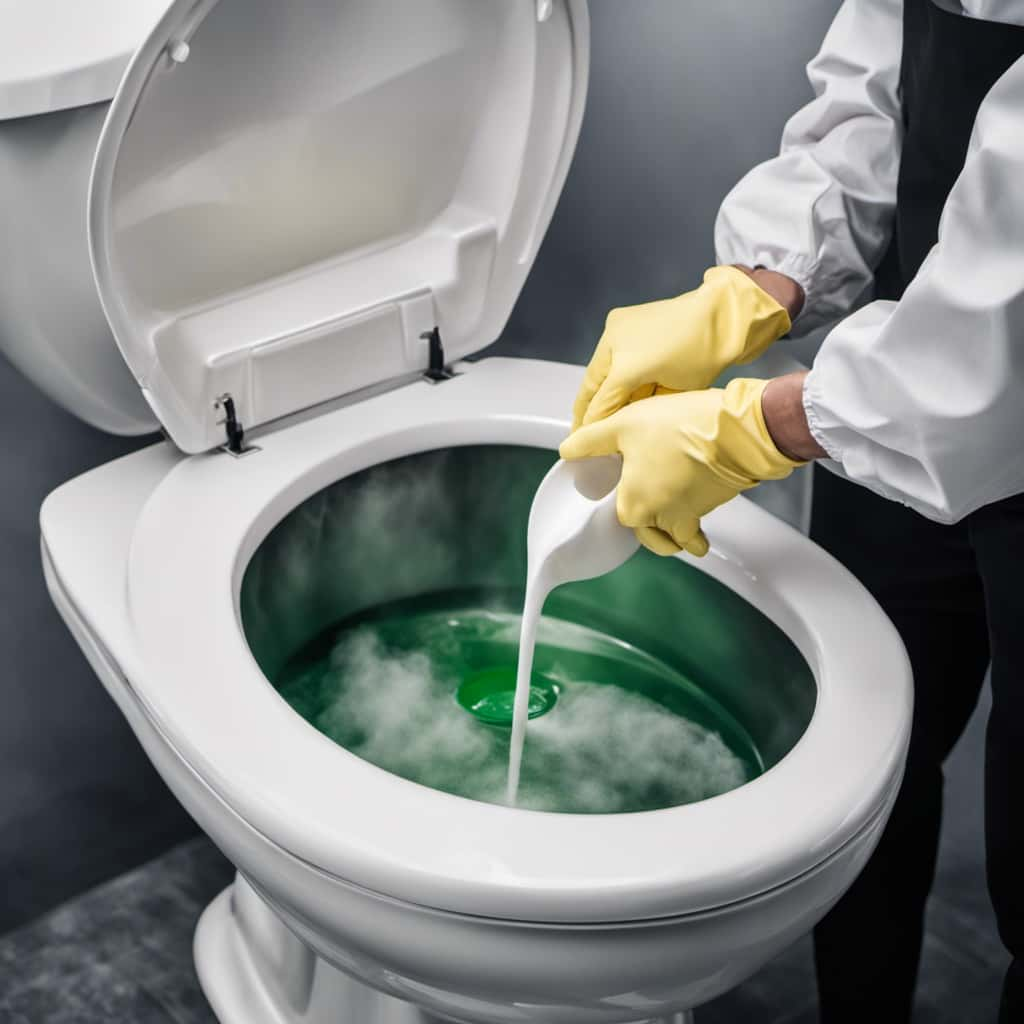
What Are Some Common Misconceptions About GPF and Its Impact on Water Conservation?
Common misconceptions about GPF and its impact on water conservation stem from a lack of understanding the relationship between GPF and toilet flushing efficiency. Proper education is crucial to dispel these myths.
Conclusion
In conclusion, understanding GPF is crucial when it comes to making informed toilet choices.
By knowing what GPF means and how it’s measured, we can make environmentally conscious decisions and reduce water usage.
Just like a river flowing freely, let’s ensure our toilets are efficient and sustainable, minimizing our impact on the environment.
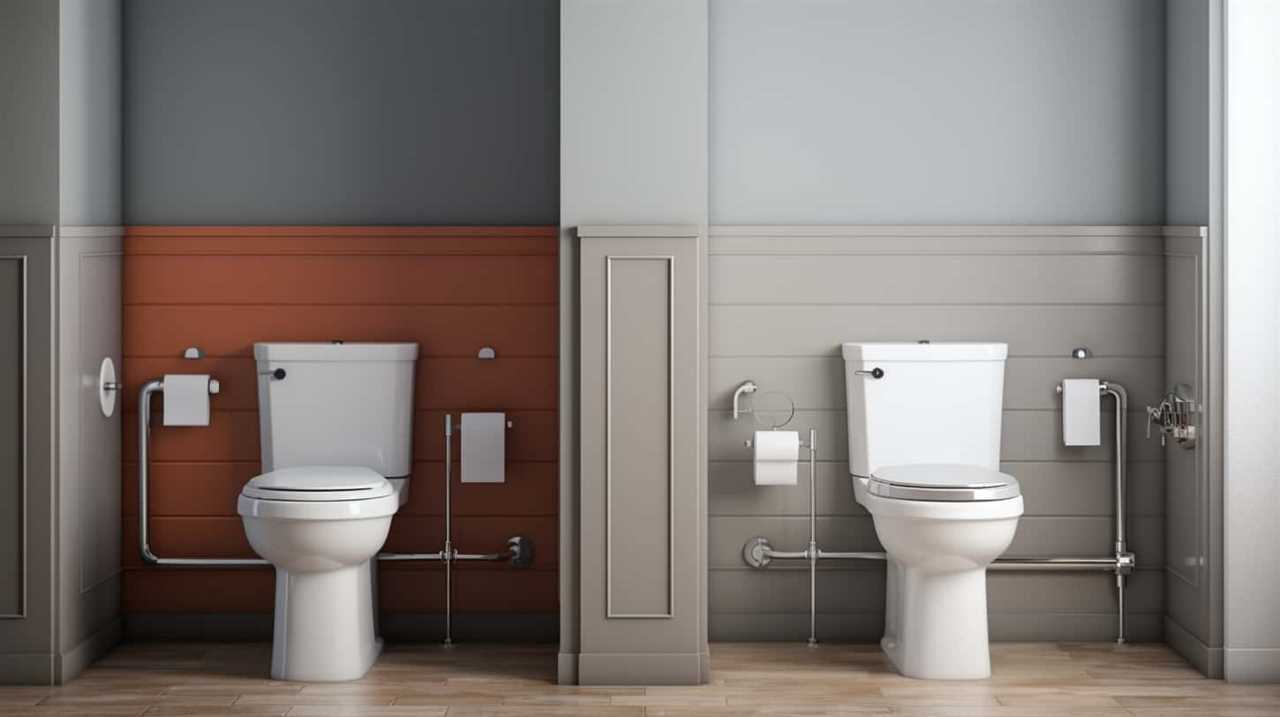
Together, we can make a difference, one flush at a time.
With an impeccable eye for detail and a passion for bathroom-related, Ava leads our editorial team gracefully and precisely.
Under her guidance, Best Modern Toilet has flourished as the go-to resource for modern bathroom enthusiasts. In her free time, you might find Ava exploring antique shops and looking for vintage bathroom fixtures to add to her collection.
FAQ - Advanced Bathroom Queries
Why Won’t My Toilet Flush Without Power

If you’ve ever been stuck in a challenging situation during a power outage, frantically trying to figure out why your toilet isn’t flushing, don’t worry – we’re here to explain this common dilemma.
In this article, we’ll explore the role of electricity in toilet flushing and delve into the components of a power-dependent flushing system. We’ll also uncover the reasons behind toilet flushing failure during power outages and provide alternative methods to ensure a functional toilet, even without power.
So, let’s dive in and master the art of flushing without electricity!
Key Takeaways
- Electricity is essential for the flush mechanism of modern toilets.
- Power outages can disrupt the functioning of the components that control flushing.
- Alternative methods for flushing a toilet without power include manually filling the tank, pouring water into the bowl, or using portable toilet options.
- Preparing for power outages involves installing backup power sources, stocking up on water, considering water-saving toilets, and educating oneself on alternative flushing methods.
The Role of Electricity in Toilet Flushing
In our experience, the main role of electricity in toilet flushing is through the operation of the electrically-powered flush mechanism. This mechanism is responsible for initiating the flushing action by activating the water flow and creating the necessary pressure to remove waste from the bowl.

The impact of water pressure on toilet flushing can’t be overstated. Adequate water pressure ensures a strong and efficient flush, while low water pressure can result in incomplete waste removal and potential clogs.
The history of electricity in toilet technology dates back to the early 20th century when electrically-powered flush mechanisms were first introduced. Since then, advancements in technology have led to more efficient and effective flushing systems, improving overall toilet performance.
Understanding the role of electricity in toilet flushing is crucial for maintaining a properly functioning toilet system.
Components of a Power-Dependent Flushing System
To understand the components of a power-dependent flushing system, we need to examine the inner workings of the toilet. Power saving toilet technology has become increasingly popular due to its ability to reduce energy consumption and minimize the impact of power outages on water pressure. Let’s take a closer look at the key components involved in this system.

| Component | Function |
|---|---|
| Flapper valve | Controls the release of water from the tank into the bowl |
| Fill valve | Regulates the water level in the tank |
| Flush valve | Opens to allow water to flow into the bowl during flushing |
During a power outage, the lack of electricity can disrupt the functioning of these components, particularly the flapper valve. Without power, the flapper valve may fail to open, preventing the water from being released into the bowl. Additionally, the fill valve may not be able to replenish the water in the tank, leading to decreased water pressure and a weaker flush. Understanding these components helps us comprehend why a toilet may not flush without power.
Common Reasons for Toilet Flushing Failure During Power Outages
When power outages occur, we often experience toilet flushing failure due to several common reasons. One of the main causes is the reliance on electricity for the flushing mechanisms of modern toilets. These mechanisms, such as electric pumps or pressure-assisted systems, require power to operate. Without electricity, these mechanisms can’t generate the necessary force to flush the toilet effectively.
Another reason for flushing failure during power outages is a clogged or malfunctioning toilet. Blockages in the pipes or a faulty flush valve can impede the flushing process, even when power is available. Troubleshooting toilet flushing issues should involve checking for blockages, ensuring the flush valve is functioning properly, and considering alternative methods for flushing.
Understanding these common reasons for toilet flushing failure is crucial in finding solutions and ensuring proper functionality, especially during power outages. In the next section, we’ll explore alternative methods for flushing a toilet without power.

Alternative Methods for Flushing a Toilet Without Power
During power outages, when the reliance on electricity for toilet flushing mechanisms renders them ineffective, it’s important to consider alternative methods for flushing a toilet without power.
In emergency situations, there are several solutions that can be implemented to ensure proper sanitation and water conservation.
One option is to manually fill the toilet tank with water using a bucket or container. By pouring the water into the bowl, it will create enough force to flush the waste down the drain.
Another method is to use a portable camping toilet or a portable toilet seat that can be placed on top of a bucket or other container.

These emergency solutions can help maintain hygiene and prevent the spread of diseases during power outages, while also conserving water.
Preparing for Power Outages: Tips to Ensure a Functional Toilet
In order to prepare for power outages and ensure a functional toilet, we can continue the discussion by exploring some helpful tips. Here are three key suggestions to enhance toilet hygiene and emergency preparedness:
- Install a backup power source: Consider investing in a generator or a battery backup system to keep essential appliances, including your toilet, running during power outages. This will allow you to maintain proper sanitation even when the electricity is down.
- Stock up on water: Have an adequate supply of water stored for emergencies. You can use this water to manually flush the toilet by pouring it directly into the bowl. Aim for at least one gallon of water per person per day to cover your basic needs.
- Learn manual flushing techniques: Familiarize yourself with alternative methods for flushing the toilet without power. For instance, you can manually fill the toilet tank using a bucket of water to create enough pressure for a flush.
Frequently Asked Questions
How Does a Power Outage Affect the Operation of a Toilet?
During a power outage, a toilet may not flush because it relies on electricity to activate the flushing mechanism. Without power, the backup generator or emergency plumbing may be needed to restore functionality.
Can I Manually Flush a Toilet That Is Dependent on Electricity?
Yes, you can manually flush a toilet that relies on electricity. By using the emergency toilet flush or manually filling the tank and operating the lever, you can still achieve a functioning flush without power.

Are There Any Alternative Methods to Flush a Toilet Without Power?
Emergency toilet solutions include DIY toilet flush options. When there is no power, alternative methods can be used to manually flush a toilet. These methods ensure functionality during emergencies or power outages.
What Are the Common Reasons for Toilet Flushing Failure During a Power Outage?
The common reasons for toilet flushing failure during a power outage include a lack of power to operate the toilet flushing mechanism and potential issues with the water supply. Troubleshooting toilet flushing may involve checking the power source and ensuring proper water flow.
How Can I Prepare My Toilet for a Power Outage to Ensure It Remains Functional?
To prepare our toilet for a power outage and ensure it remains functional, we can take measures such as installing a backup generator, using water conservation techniques, and considering portable toilet options.
Conclusion
In conclusion, power outages can disrupt the functioning of toilets, which rely on electricity for flushing.

One interesting statistic to consider is that during a power outage, the average person flushes the toilet around 2,500 times per year.
This visualizes the potential inconvenience and importance of having alternative methods in place to ensure a functional toilet during such situations.
With an impeccable eye for detail and a passion for bathroom-related, Ava leads our editorial team gracefully and precisely.
Under her guidance, Best Modern Toilet has flourished as the go-to resource for modern bathroom enthusiasts. In her free time, you might find Ava exploring antique shops and looking for vintage bathroom fixtures to add to her collection.
FAQ - Advanced Bathroom Queries
Are You Allowed to Flush Toilet Paper

Are we overlooking the consequences of flushing toilet paper?
In this article, we explore the environmental consequences and plumbing issues associated with this common practice.
We’ll also delve into alternatives and proper disposal methods recommended by plumbing and environmental experts.
Join us as we navigate the complexities of this topic and gain a deeper understanding of whether we are allowed to flush toilet paper.

Get ready to master the art of responsible waste management.
Key Takeaways
- Flushing toilet paper contributes to water scarcity and wastes valuable water resources.
- Flushing too much toilet paper can lead to clogging and damage to sewage systems.
- Composting toilets and bidet attachments are sustainable alternatives to flushing toilet paper.
- Proper disposal methods, such as recycling and composting, help reduce the environmental impact of toilet paper.
Environmental Impact of Flushing Toilet Paper
Flushing toilet paper has a significant environmental impact, and we should be aware of its consequences. When we flush toilet paper, it contributes to two major environmental issues: water scarcity and deforestation.
Firstly, the production of toilet paper requires a significant amount of water. With water scarcity becoming a growing concern around the world, it’s important to recognize that flushing toilet paper wastes this valuable resource.
Secondly, the production of toilet paper contributes to deforestation. Trees are cut down to make pulp, which is then processed into toilet paper. This deforestation not only destroys ecosystems and habitats but also reduces the Earth’s ability to absorb carbon dioxide.

Therefore, it’s crucial that we consider alternative options, such as using bidets or recycled toilet paper, to minimize the environmental impact of flushing toilet paper.
Plumbing Issues Caused by Flushing Toilet Paper
Although it may seem convenient, flushing toilet paper can lead to various plumbing issues. One of the most common problems is toilet paper clogging. When too much toilet paper is flushed, it can accumulate and create blockages in the pipes. This can result in toilets that do not flush properly or even overflowing toilets. In addition to clogging, flushing toilet paper can also cause damage to the sewage system. The fibers in toilet paper do not break down easily, especially in older plumbing systems. Over time, these fibers can build up and cause damage to the pipes, leading to costly repairs. To illustrate the potential consequences of flushing toilet paper, refer to the table below:
| Plumbing Issues Caused by Flushing Toilet Paper |
|---|
| Toilet paper clogging |
| Sewage system damage |
To avoid these problems, it is best to dispose of toilet paper in a waste bin instead of flushing it. This simple change in behavior can help maintain the integrity of your plumbing system and prevent unnecessary expenses.
Alternatives to Flushing Toilet Paper
To avoid the plumbing issues caused by flushing toilet paper, we can explore alternative methods of disposal.

One such alternative is the use of composting toilets. Composting toilets are designed to efficiently break down human waste, including toilet paper, using natural processes. These toilets separate solid waste from liquid waste and utilize aerobic bacteria to decompose the organic matter. The resulting compost can then be used as a nutrient-rich fertilizer for plants.
Another alternative is the use of bidet attachments. Bidets are devices that use water to clean oneself after using the toilet. Bidet attachments can be easily installed on existing toilets and provide a more hygienic and environmentally friendly option.
Proper Disposal Methods for Toilet Paper
We can dispose of toilet paper properly by simply throwing it in the designated trash bin.
However, there are also other environmentally friendly options for toilet paper disposal. One option is toilet paper recycling. Some companies specialize in recycling toilet paper, where it’s collected, processed, and turned into new paper products. This not only reduces waste but also saves trees and energy.

Another option is composting toilet paper. Composting toilet systems are designed to break down organic waste, including toilet paper, into nutrient-rich compost. This compost can then be used as fertilizer for gardens and plants. It’s important to note that not all toilet paper is suitable for composting, so it’s essential to choose toilet paper that’s specifically labeled as compostable.
Recommendations From Plumbing and Environmental Experts
According to plumbing and environmental experts, our recommendation is to consult with your local water and sanitation authorities for guidelines on flushing toilet paper. These authorities are knowledgeable about the specific waste management systems in your area and can provide you with accurate information on how to properly dispose of toilet paper.
It’s important to follow their guidelines to ensure the efficient and environmentally friendly management of toilet paper waste.
Additionally, it’s worth considering eco-friendly toilet paper options, which are becoming increasingly popular. These options are made from recycled materials or sustainable sources, reducing the environmental impact associated with traditional toilet paper production.

Frequently Asked Questions
Is It True That Flushing Toilet Paper Can Cause Plumbing Issues?
Flushing toilet paper can cause plumbing issues. The plumbing consequences include clogged pipes and potential damage to the septic system. It is important to properly dispose of toilet paper in a waste bin to prevent these problems.
What Are Some Alternative Options to Flushing Toilet Paper?
When it comes to the question of alternative options to flushing toilet paper, one option that comes to mind is using a bidet. The benefits of using bidets include improved hygiene and reduced paper waste.
How Should Toilet Paper Be Properly Disposed Of?
Toilet paper should be properly disposed of by either recycling it or composting it. Recycling toilet paper helps to reduce waste, while composting toilet paper allows it to break down naturally and become a nutrient-rich soil amendment.
What Are the Recommendations From Plumbing Experts Regarding Toilet Paper Usage?
Plumbing experts recommend considering toilet paper alternatives and eco-friendly options. It’s essential to be mindful of proper disposal methods and not flush non-flushable items to prevent clogs and damage to the plumbing system.

How Does Flushing Toilet Paper Impact the Environment?
Flushing toilet paper can have a negative impact on the environment. Toilet paper production contributes to deforestation, as trees are cut down to make it. Proper disposal methods, such as using a designated bin, can help mitigate these effects.
Conclusion
In conclusion, it’s crucial to consider the environmental impact and potential plumbing issues caused by flushing toilet paper.
Instead, explore alternatives such as bidets or wet wipes that can be disposed of properly.
By doing so, we can help preserve our planet and avoid costly plumbing repairs.

Remember, like a drop in a vast ocean, our small choices can create ripples of positive change.
With an impeccable eye for detail and a passion for bathroom-related, Ava leads our editorial team gracefully and precisely.
Under her guidance, Best Modern Toilet has flourished as the go-to resource for modern bathroom enthusiasts. In her free time, you might find Ava exploring antique shops and looking for vintage bathroom fixtures to add to her collection.
FAQ - Advanced Bathroom Queries
Can You Flush Toilet if Water Is off

Picture a scenario in which the water in your household suddenly vanishes, rendering you unable to flush the toilet.
Don’t panic! In this article, we will explore various methods to overcome this challenge and keep your bathroom functioning smoothly.
From understanding different types of toilets to utilizing alternative water sources and even resorting to using buckets or containers, we will equip you with the knowledge to handle such situations with ease.
Prepare for emergencies and master the art of flushing without water!

Key Takeaways
- Understanding the type of toilet you have is crucial in determining if it can be flushed when the water is off.
- Alternative water sources like rainwater harvesting and greywater systems can be used for flushing toilets during water shortages.
- Regular maintenance of toilets is important to ensure proper functioning and longevity of the system.
- Emergency preparedness involves keeping emergency supplies, having backup water sources, learning makeshift plumbing techniques, and staying informed about local emergency protocols and resources.
Type of Toilet Matters
We found that the type of toilet you have will determine whether or not you can flush it when the water is off. This is particularly relevant for portable toilets and composting toilets.
Portable toilets, which are commonly used in camping or outdoor events, typically have their own built-in flushing system that doesn’t rely on a constant water supply. Therefore, even if the water is turned off, you can still flush these toilets.
On the other hand, composting toilets, which are designed to break down waste into compost, don’t require water for flushing. Instead, they use a dry composting process, making them completely independent of water supply.
Understanding the type of toilet you have is crucial in determining whether or not you can flush it when the water is off.

Now, let’s explore alternative water sources for flushing toilets.
Alternative Water Sources
Now let’s explore the alternative water sources available for flushing toilets when water is turned off. When faced with a water shortage, it’s important to consider rainwater harvesting and water conservation techniques as viable options. Rainwater harvesting involves collecting and storing rainwater for later use. This can be done by installing rain barrels or cisterns that capture rainwater from rooftops and divert it to a storage container. To give you a better understanding of the options available, here is a table outlining some alternative water sources for flushing toilets:
| Alternative Water Sources | Description |
|---|---|
| Rainwater harvesting | Collecting and storing rainwater for later use. |
| Water conservation | Implementing strategies to reduce water usage. |
Using a Bucket or Container
To continue the discussion from the previous subtopic, let’s explore how we can utilize a bucket or container to flush the toilet when the water is turned off.
When it comes to using a bucket or container for flushing, there are a few key points to consider:

- Bucket vs. container: Both options can be used effectively for flushing. A bucket offers a larger capacity, allowing for multiple flushes with less trips to refill. On the other hand, a container may be more convenient to carry and pour into the toilet.
- Water conservation methods: Using a bucket or container for flushing helps conserve water during periods of water shortage. By manually pouring water into the toilet, you can avoid using unnecessary amounts of water from alternative sources.
- Proper handling: It’s important to handle the bucket or container with care to avoid spills and ensure efficient flushing. Be mindful of the weight and pour steadily to avoid accidents.
- Cleaning and sanitizing: After using a bucket or container to flush the toilet, it’s crucial to clean and sanitize them thoroughly to maintain hygiene and prevent the spread of bacteria.
In order to maintain a functional toilet system, it’s important to regularly maintain and inspect the various components. Now, let’s move on to discussing the importance of regular maintenance.
Importance of Regular Maintenance
Regular maintenance of a toilet system is crucial for ensuring its proper functioning and longevity. Neglecting regular maintenance can lead to various issues such as clogs, leaks, and inefficiency. Hiring professionals for toilet maintenance offers numerous benefits. They have the expertise and tools to identify and fix problems before they escalate, saving you time, money, and frustration. Additionally, professionals can provide valuable advice on how to optimize your toilet system’s performance and extend its lifespan.
To illustrate the importance of regular maintenance, consider the following common mistakes that homeowners make:
| Common Maintenance Mistakes | Consequences |
|---|---|
| Neglecting to clean the toilet regularly | Accumulation of dirt, stains, and unpleasant odors |
| Failing to check and replace worn-out parts | Increased risk of leaks and decreased efficiency |
| Ignoring unusual noises or slow flushing | Potential for major clogs or system failures |
Emergency Preparedness Tips
After prioritizing regular maintenance, it’s important to be prepared for emergencies in case the water to your toilet is shut off. Here are four essential emergency preparedness tips to help you navigate such situations:

- Emergency Supplies: Keep a stash of essential items such as bottled water, non-perishable food, flashlights, batteries, and a portable radio. These supplies will come in handy during a water outage or any other emergency.
- Water Storage: Consider storing additional water in large containers or water storage tanks. This will ensure you have access to water for flushing the toilet and other necessary uses during a water shutdown.
- Sanitation Alternatives: In the absence of water, utilize alternative sanitation methods, such as using disposable hygiene products or keeping a supply of sanitary wipes and hand sanitizer.
- Communication Plans: Develop a communication plan with your household members to stay connected during emergencies. Establish a meeting point and assign responsibilities to ensure everyone’s safety and well-being.
Frequently Asked Questions
Can I Flush My Toilet if the Water Supply to My House Is Temporarily Shut Off?
Yes, we can flush the toilet if the water is temporarily shut off. There are alternative toilet flushing techniques, such as pouring a bucket of water into the bowl. It’s important to conserve water in these situations.
What Types of Toilets Are More Likely to Be Able to Flush Without Water?
Waterless toilets, such as composting toilets and incinerating toilets, are more likely to be able to flush without water. DIY methods for flushing without water include pouring a bucket of water into the bowl.
Are There Any Alternative Water Sources That Can Be Used to Flush the Toilet if the Water Is Off?
Yes, there are alternative water sources that can be used to flush the toilet if the water is off. Options include using stored rainwater, melted snow, or even water from other sources like a swimming pool, as long as water conservation practices are followed.
Can I Use a Bucket or Container of Water to Manually Flush the Toilet?
Yes, we can use a bucket or container of water to manually flush the toilet. It’s a common alternative when the water is off. Just pour the water forcefully into the bowl to create a flushing effect.

Why Is Regular Maintenance of the Toilet Important for Its Proper Functioning, Especially During Water Shortages or Emergencies?
Regular toilet maintenance is crucial for proper functioning, especially during water shortages or emergencies. By keeping the toilet clean, checking for leaks, and avoiding flushing non-flushable items, you can prevent clogs and ensure it works efficiently.
Conclusion
So, the next time you find yourself in a situation where the water is off and you need to use the toilet, remember that it’s not the end of the world.
With the right type of toilet, alternative water sources, and a little improvisation, you can still flush and maintain your sanity.
Just don’t forget the importance of regular maintenance and emergency preparedness.

After all, who knew that something as simple as flushing a toilet could become a lesson in survival?
With an impeccable eye for detail and a passion for bathroom-related, Ava leads our editorial team gracefully and precisely.
Under her guidance, Best Modern Toilet has flourished as the go-to resource for modern bathroom enthusiasts. In her free time, you might find Ava exploring antique shops and looking for vintage bathroom fixtures to add to her collection.
-

 Reviews2 months ago
Reviews2 months agoBest Toilet Air Freshener: Top 10 Picks for a Fresh-Smelling Bathroom [2024]
-

 FAQ - Advanced Bathroom Queries3 months ago
FAQ - Advanced Bathroom Queries3 months agoGuide: How to Use Drano Max Gel in Your Toilet
-

 FAQ - Advanced Bathroom Queries1 month ago
FAQ - Advanced Bathroom Queries1 month agoWhich Countries Use Bidets the Most
-

 FAQ - Advanced Bathroom Queries3 months ago
FAQ - Advanced Bathroom Queries3 months agoWhy Does My Poop Leave Streaks in the Toilet
-

 Reviews2 months ago
Reviews2 months agoBest Waterless Toilets: Top Options for Eco-Friendly Bathrooms [2024]
-

 Buying Guides2 months ago
Buying Guides2 months agoWhat to Do When You Accidentally Flushed Something Down the Toilet
-

 FAQ - Advanced Bathroom Queries3 months ago
FAQ - Advanced Bathroom Queries3 months agoHow Do Toilets Work in Bali
-

 FAQ - Advanced Bathroom Queries3 months ago
FAQ - Advanced Bathroom Queries3 months agoWhat to Do if You Accidentally Flushed Something Down the Toilet





















